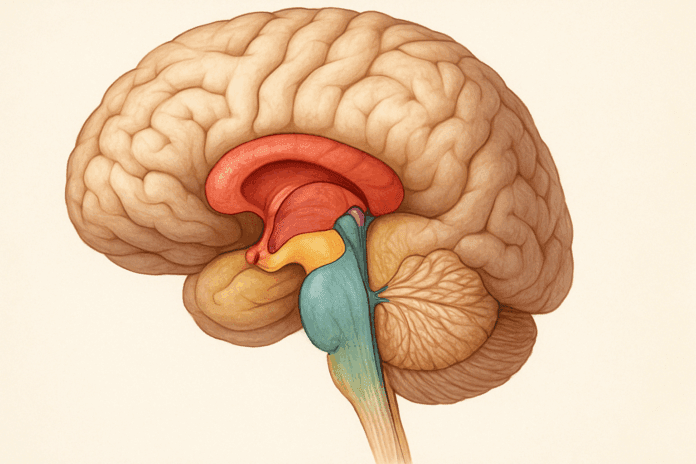Introduction: The Vital Role of the Midbrain in Mental and Cognitive Health
The midbrain, often referred to as the middle brain, is a small yet incredibly powerful structure nestled between the forebrain and hindbrain. Though modest in size, it plays a monumental role in a wide array of functions essential for maintaining mental clarity, emotional balance, and sensory processing. For anyone seeking to understand how brain function influences overall mental health, gaining insight into the function of the midbrain offers a foundational starting point. The midbrain acts as a central processing station, relaying sensory information and coordinating responses that are critical for day-to-day functioning. Yet, despite its importance, public knowledge about the middle brain remains limited, often overshadowed by discussions focused on the larger cerebral cortex or limbic system.
In today’s world, where mental health concerns are growing at an unprecedented rate, understanding the function of the midbrain becomes increasingly relevant. Whether you are looking to enhance focus, manage anxiety, or improve emotional regulation, the health and efficiency of the middle brain can profoundly impact your cognitive well-being. This article delves deeply into the middle brain structures and explores their connection to emotional, cognitive, and behavioral health. By the end, you will not only have a clearer understanding of what the middle brain is but also how it operates, why it matters, and what you can do to support its function in your everyday life.
You may also like: Boost Brain Power Naturally: Evidence-Based Cognitive Training Activities and Memory Exercises That Support Long-Term Mental Health
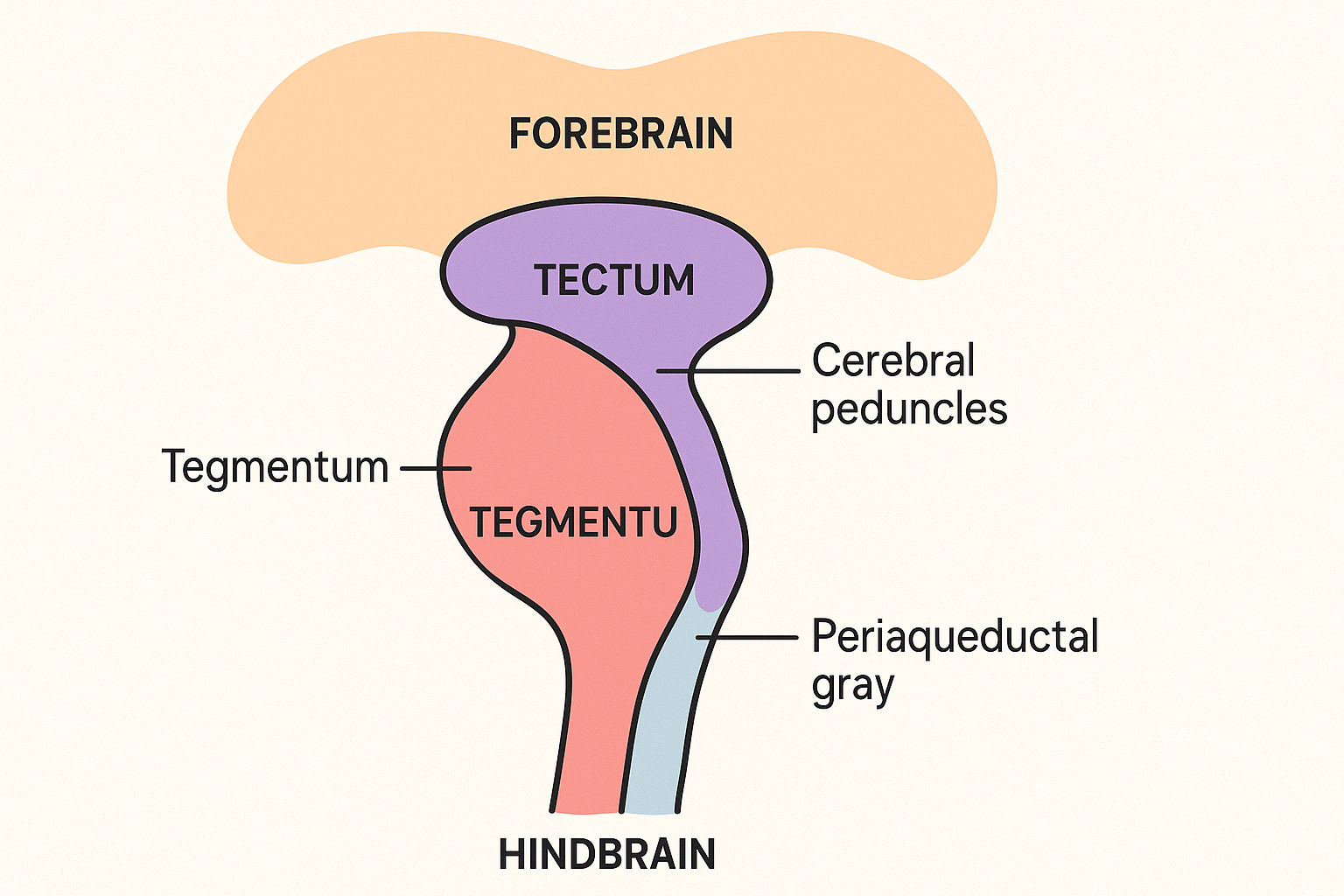
Defining the Middle Brain: Location, Structure, and Role in the Central Nervous System
Understanding what the middle brain is requires a deeper look into neuroanatomy. The midbrain, or mesencephalon, is part of the brainstem and sits just above the pons and below the thalamus. It is comprised of multiple key structures, including the tectum, tegmentum, cerebral peduncles, and the periaqueductal gray. These middle brain structures serve as conduits for sensory and motor pathways, connecting higher brain centers with the spinal cord and integrating various functions such as vision, hearing, movement, and arousal. Importantly, the midbrain also plays a role in modulating pain and managing motor control, two functions that are closely tied to mental and emotional states.
From a structural perspective, the midbrain is divided into dorsal (tectum) and ventral (tegmentum) components. The tectum includes the superior and inferior colliculi, which are crucial for visual and auditory processing. The tegmentum contains a variety of nuclei involved in motor coordination and reward signaling, such as the red nucleus and the substantia nigra. These anatomical features contribute to the essential regulatory functions of the midbrain. The cerebral peduncles, which are large bundles of nerve fibers, connect the cerebral cortex to the brainstem and spinal cord, enabling voluntary motor function and higher-order control.
The function of the midbrain is particularly significant when considering how it interacts with other parts of the central nervous system. For example, it helps mediate the reticular activating system, a network responsible for wakefulness and attention. It also facilitates communication between the limbic system and the prefrontal cortex, helping to regulate emotional responses. Understanding the intricate design and interconnected roles of these middle brain structures underscores why even small dysfunctions in this region can lead to profound mental health effects, ranging from anxiety and depression to cognitive impairment and motor disorders.
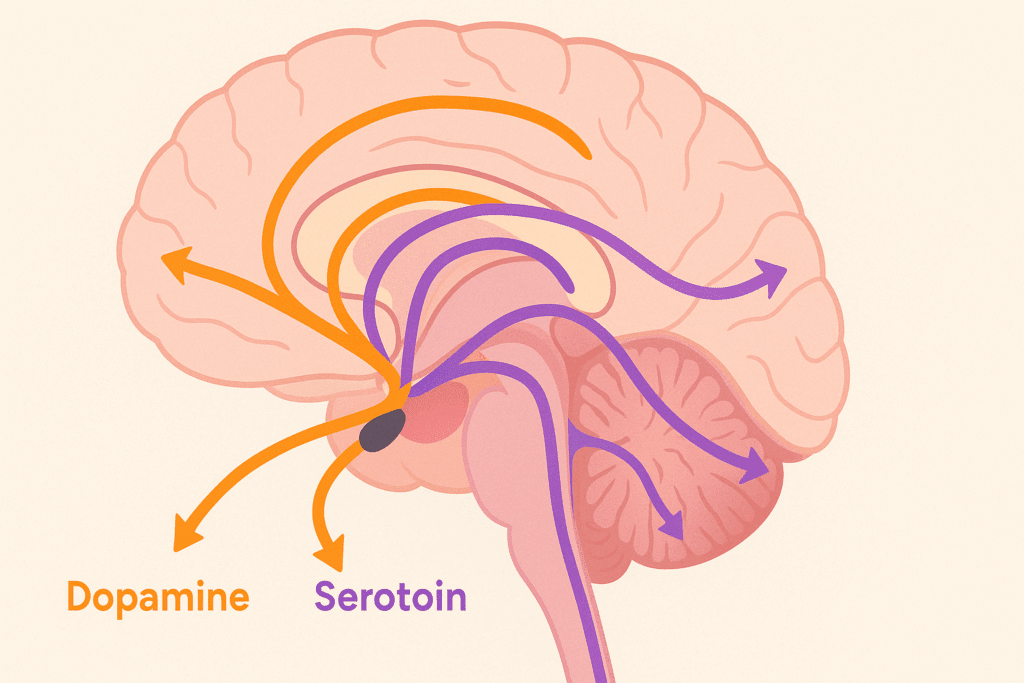
Neurotransmitters and the Midbrain: Dopamine, Serotonin, and Emotional Regulation
One of the most critical functions of the midbrain is its role in the production and regulation of neurotransmitters, particularly dopamine and serotonin. These chemical messengers are intimately tied to mood, reward processing, and motivation. The substantia nigra, located within the midbrain, is a major site for dopamine production. Damage to this area is famously linked to Parkinson’s disease, a neurological disorder characterized by motor dysfunction, but it also has significant implications for mental health, particularly in areas of motivation and depression.
The ventral tegmental area (VTA), another midbrain structure, is part of the brain’s reward circuitry and is crucial for dopamine release in the mesolimbic and mesocortical pathways. These pathways influence how we perceive pleasure, make decisions, and regulate emotions. Disruptions in dopamine signaling from the midbrain to the prefrontal cortex have been implicated in disorders such as schizophrenia, addiction, and ADHD. This reveals how the function of the midbrain is deeply intertwined with our ability to maintain emotional and cognitive balance.
Serotonin, while primarily produced in the raphe nuclei of the brainstem, also interacts with the midbrain to influence mood and anxiety levels. The midbrain’s integration of serotonergic inputs with other sensory and motor pathways creates a platform for emotional regulation that is sensitive to environmental stimuli. For example, when stress or trauma is experienced, the midbrain can either amplify or moderate the brain’s emotional response depending on the efficiency and health of its neural circuitry.
Beyond its biochemical role, the midbrain also facilitates feedback loops with the hypothalamus and amygdala, structures involved in fear processing and hormonal regulation. These feedback mechanisms are essential for understanding how the middle brain works in real-time to interpret threats and mediate stress responses. This also highlights why strategies aimed at improving midbrain function—such as mindfulness, cognitive-behavioral therapy, and neurofeedback—can be effective tools in supporting long-term mental health.
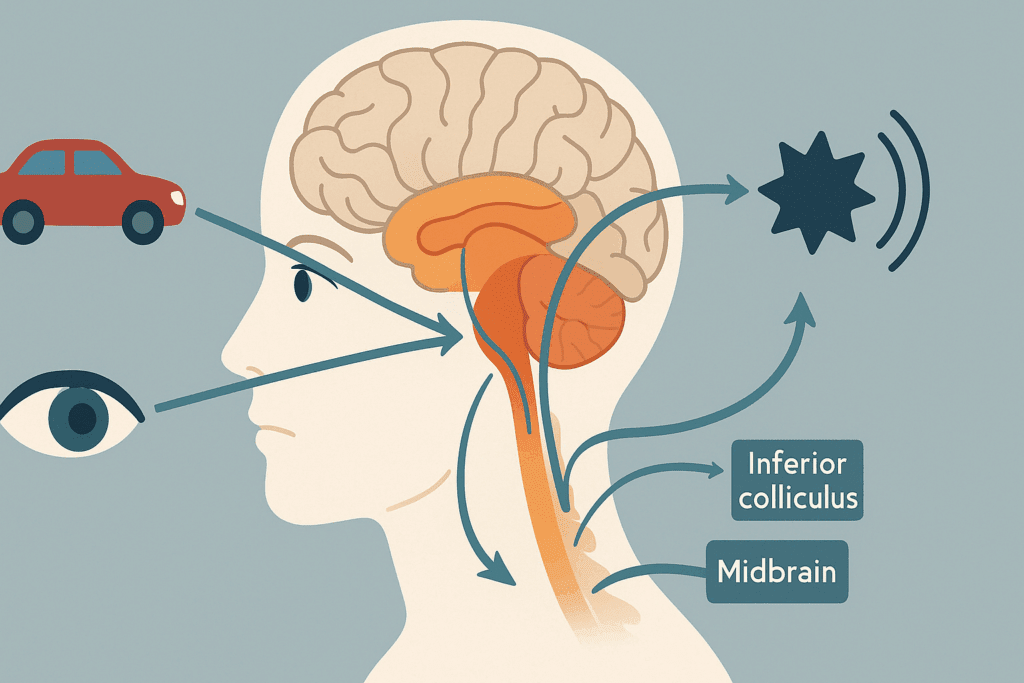
Sensory Processing and the Midbrain’s Integration of External Stimuli
Among the most fascinating aspects of the midbrain’s function is its role in integrating sensory information. The superior and inferior colliculi located in the tectum serve as relay centers for visual and auditory data, respectively. These structures coordinate reflexive movements and attentional shifts based on sensory input. For instance, turning your head toward a loud noise or rapidly focusing your eyes on a moving object are actions governed by these middle brain structures. Such reflexive responses are crucial for survival and play a role in social interaction, attention, and environmental awareness.
The function of the midbrain in sensory integration is not merely mechanical but deeply cognitive and emotional. When a person hears an alarming sound or sees an emotionally charged image, the midbrain helps filter and prioritize the information before relaying it to higher brain centers for more complex processing. This preliminary processing can shape how a stimulus is ultimately perceived, colored by past experiences and emotional context. This makes the midbrain not just a relay station, but an active participant in shaping perception and emotional resonance.
Disruptions in midbrain function can manifest in sensory processing disorders, heightened startle responses, and difficulties in focusing attention. These are symptoms often observed in conditions like PTSD, autism spectrum disorder, and sensory integration disorder. In such cases, therapies aimed at re-regulating midbrain processing—such as occupational therapy, eye movement desensitization and reprocessing (EMDR), and exposure therapy—can offer targeted improvements. By enhancing the midbrain’s ability to handle sensory stimuli efficiently, these interventions also improve emotional resilience and cognitive flexibility.
When we speak about what is the middle brain and why it matters, we are essentially talking about the hub where physical reality meets emotional interpretation. Its ability to influence what we notice, how we react, and how we feel in the presence of stimuli makes it a crucial mediator between the outer world and our inner mental landscape. This underscores the immense value in maintaining midbrain health and understanding its core functions as part of a broader mental health strategy.
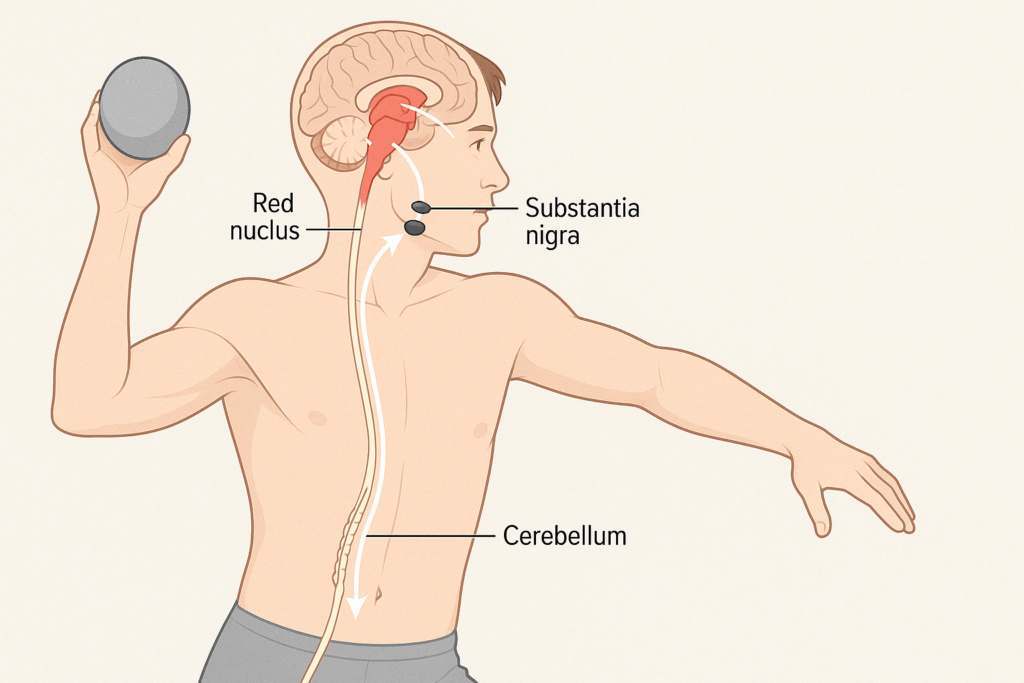
Motor Coordination and Voluntary Movement: How the Midbrain Orchestrates Motion
Beyond its influence on emotional and sensory processing, the midbrain also plays a pivotal role in motor coordination. The red nucleus and substantia nigra are two of the most important midbrain structures involved in motor control. The red nucleus is particularly active in the coordination of limb movement, while the substantia nigra’s dopaminergic neurons facilitate the initiation of voluntary motion. These components work in tandem to ensure that our physical movements are smooth, purposeful, and adaptive to changing environments.
The function of the midbrain in motor regulation extends to postural adjustments and gait stability, both of which are fundamental to physical independence and daily functionality. When midbrain activity is compromised, individuals may experience symptoms like rigidity, tremors, and slowed movement—all hallmark features of Parkinsonian syndromes. What is particularly compelling is that these motor impairments are not purely physical in nature; they often co-occur with emotional disturbances such as apathy, depression, and anxiety. This duality further affirms that the motor and emotional domains share overlapping midbrain pathways.
Importantly, emerging research suggests that the midbrain’s role in motion extends into cognitive processes like motor planning and the integration of sensorimotor feedback. For example, the ability to catch a falling object or navigate a crowded space involves rapid signal transmission between the midbrain, cerebellum, and cerebral cortex. The midbrain filters incoming stimuli, prioritizes motor commands, and adjusts output based on real-time feedback. This function is vital not just for athletes or individuals with mobility challenges but for everyone navigating a dynamic and often unpredictable world.
Understanding the function of the midbrain in movement planning also opens up new possibilities for rehabilitation. Neuromodulation techniques like deep brain stimulation and transcranial magnetic stimulation are showing promise in restoring midbrain function and alleviating both motor and cognitive symptoms in patients with neurodegenerative disorders. These findings reaffirm the centrality of midbrain structures in bridging the gap between motion and emotion—making it a vital area of focus for both neuroscientific research and holistic mental health care.

Neuroplasticity in the Midbrain: Adaptive Potential and Recovery After Injury
The midbrain’s remarkable ability to adapt and reorganize in response to environmental changes and injury highlights the importance of neuroplasticity within this region. Neuroplasticity refers to the brain’s capacity to form new neural connections, rewire existing pathways, and adapt to functional demands. While much of the research on neuroplasticity has traditionally centered on the cerebral cortex, recent studies have revealed that the midbrain also exhibits a surprising degree of plasticity, particularly in response to learning, trauma, and therapeutic interventions.
This adaptive quality of the midbrain is most apparent in individuals recovering from neurological injury. For example, when parts of the motor cortex are damaged, the midbrain can sometimes compensate by enhancing its own role in motor planning and execution. Similarly, after exposure to trauma or chronic stress, the midbrain’s ability to recalibrate emotional responses—especially through its dopaminergic and serotonergic systems—can determine the trajectory of psychological recovery. What is the middle brain if not a site of dynamic resilience, capable of transforming adversity into adaptation?
Beyond injury, neuroplasticity in the midbrain is also influenced by factors such as exercise, meditation, and cognitive training. Aerobic activity, in particular, has been shown to enhance midbrain function by promoting neurogenesis and improving dopamine regulation. Likewise, mindfulness meditation has been linked to increased connectivity between the midbrain and the prefrontal cortex, fostering better emotional regulation and cognitive control. These findings reinforce the view that supporting midbrain health through lifestyle choices can directly influence mental well-being.
Research into neuroplasticity in the midbrain is also shaping innovative therapeutic practices. Emerging techniques such as real-time functional MRI (fMRI) neurofeedback and targeted behavioral therapy aim to harness the midbrain’s capacity for change. These interventions allow patients to consciously influence midbrain activity, potentially rewiring circuits related to mood, motivation, and movement. Such advancements highlight not only the function of the midbrain but also its promise as a focal point in the next generation of mental health care.
Mental Health Disorders Linked to Midbrain Dysfunction: What the Science Reveals
As our understanding of the midbrain deepens, so too does our appreciation of its role in various mental health disorders. Disruptions in midbrain function have been implicated in a range of conditions, from mood disorders and anxiety to schizophrenia and neurodevelopmental disorders. These connections underscore the importance of identifying early signs of midbrain dysregulation and developing targeted interventions to support mental and emotional health.
One of the most well-documented links between midbrain dysfunction and mental illness is found in Parkinson’s disease. While this condition is primarily characterized by motor symptoms due to the degeneration of dopamine-producing neurons in the substantia nigra, it is also associated with high rates of depression, cognitive decline, and emotional flattening. These symptoms reflect the broader impact that midbrain dysfunction can have on emotional and psychological health, far beyond mere movement disorders.
Schizophrenia provides another window into the function of the midbrain, particularly regarding dysregulated dopamine signaling in the mesolimbic pathway. Excessive dopaminergic activity originating in the midbrain can result in hallucinations, delusions, and impaired reality testing—core features of schizophrenia. Antipsychotic medications often target these dopaminergic pathways to restore balance, though side effects can include diminished emotional responsiveness and motor disturbances, once again revealing the interconnectedness of midbrain systems.
Attention-deficit/hyperactivity disorder (ADHD), too, involves midbrain dysfunction, particularly in the areas responsible for reward processing and executive control. Imaging studies have shown reduced activation in the ventral tegmental area and abnormal connectivity with the prefrontal cortex in individuals with ADHD. These findings highlight the importance of the middle brain structures in maintaining focus, regulating impulses, and sustaining motivation. Similarly, in post-traumatic stress disorder (PTSD), heightened activity in the periaqueductal gray of the midbrain has been linked to hypervigilance and exaggerated fear responses.
The cumulative evidence clearly demonstrates that understanding the function of the midbrain is essential for making sense of a wide array of mental health conditions. Whether one is investigating the roots of psychosis, the mechanisms of anxiety, or the neurobiology of attention disorders, the middle brain remains a central player. Greater awareness and early intervention targeting midbrain pathways offer promising avenues for improved mental health outcomes.
Supporting Midbrain Health: Lifestyle, Therapy, and Preventive Strategies
Maintaining the health and function of the midbrain is not merely a matter of neurological interest—it is a critical strategy for preserving overall mental well-being. Fortunately, a growing body of research offers practical insights into how individuals can support their midbrain through both lifestyle modifications and therapeutic interventions. Understanding what is the middle brain and how to care for it can empower people to take more proactive roles in managing their emotional and cognitive health.
Physical activity is among the most effective and accessible ways to support midbrain health. Regular aerobic exercise has been shown to increase dopamine production and promote synaptic plasticity within midbrain circuits. These changes not only improve motor function but also enhance mood, focus, and motivation—traits heavily influenced by the midbrain’s dopaminergic systems. Engaging in movement-based practices such as dance, yoga, or martial arts can provide additional cognitive and emotional benefits through sensorimotor integration.
Nutritional support also plays a crucial role in maintaining midbrain function. Diets rich in omega-3 fatty acids, B vitamins, and antioxidants help protect midbrain neurons from oxidative stress and support neurotransmitter synthesis. In particular, nutrients such as tyrosine and tryptophan serve as precursors for dopamine and serotonin, respectively, directly feeding into the midbrain’s neurochemical systems. By prioritizing whole, nutrient-dense foods, individuals can nourish the neural pathways that regulate both mood and motion.
Psychological therapies that engage the brain’s emotional and sensory systems can further enhance midbrain health. Approaches like eye movement desensitization and reprocessing (EMDR), trauma-informed cognitive-behavioral therapy (CBT), and somatic experiencing target midbrain-mediated responses and promote emotional recalibration. These methods help clients form new neural connections and resolve maladaptive patterns rooted in midbrain dysfunction. When integrated with mindfulness practices or neurofeedback, the therapeutic benefits can be amplified, fostering greater resilience and mental clarity.
Finally, sleep hygiene, stress management, and social connection all contribute to a healthy midbrain. Chronic stress and sleep deprivation impair the midbrain’s ability to regulate emotions and sensory processing, while strong interpersonal relationships stimulate reward pathways and provide emotional grounding. By cultivating habits that support rest, recovery, and relational safety, individuals can optimize the function of the midbrain and protect their long-term mental health.
Frequently Asked Questions: How the Middle Brain Works
1. How does the middle brain affect decision-making and impulse control?
The function of the midbrain plays a subtle but powerful role in decision-making, especially when speed and emotional relevance are involved. While the prefrontal cortex is typically credited with rational thought, the middle brain structures help prioritize incoming stimuli and assess their importance. When someone encounters a sudden stressor or a rewarding stimulus, the midbrain can initiate fast, emotionally charged responses before conscious reasoning kicks in. This is particularly evident in situations requiring snap judgments, where the midbrain acts as an early filter. Overactivity in this region, however, can contribute to impulsivity, suggesting that balanced function of the midbrain is essential for sound judgment and behavioral restraint. Understanding what is the middle brain and how it influences our internal response systems allows for more effective strategies in impulse regulation, especially for individuals with ADHD or behavioral disorders.
2. Can training the senses enhance the performance of the middle brain?
Yes, sensory training can directly influence the function of the midbrain by refining how stimuli are processed and prioritized. Activities such as sound localization drills, proprioceptive exercises, and even aromatherapy can stimulate middle brain structures like the superior colliculus and the periaqueductal gray. These middle brain structures are responsible for integrating multisensory information and initiating appropriate responses. The more efficiently the middle brain integrates sensory data, the more accurate and rapid our reactions become. Recognizing what is the middle brain and using targeted sensory exercises allows clinicians to create therapies that improve attention, spatial awareness, and sensory modulation in populations such as athletes, musicians, and individuals recovering from neurological injury.
3. What role does the middle brain play in creativity and imagination?
The middle brain may not be the primary center for creativity, but it significantly contributes to the process by regulating the flow of sensory input and emotional tone. The function of the midbrain influences which external stimuli gain access to higher cortical centers, subtly guiding attention and imaginative focus. For example, someone with heightened dopaminergic activity in the midbrain may experience more vivid imagery or emotional richness during creative tasks. Moreover, the middle brain structures help determine emotional salience, which can inspire the intensity or urgency behind artistic expression. By understanding what is the middle brain and its relationship to the sensory and emotional experience, creative professionals can better harness spontaneous insight while also managing overstimulation or distraction.
4. How might virtual reality impact midbrain activity and function?
Virtual reality (VR) technologies can stimulate the midbrain in unique and powerful ways by delivering immersive, multisensory experiences. The superior and inferior colliculi within the middle brain structures are especially sensitive to visual and auditory inputs, and VR can overload or train these areas depending on the content. Therapeutically, VR has been used to desensitize phobic responses and recondition trauma-related neural pathways by activating the midbrain’s threat-response centers in controlled environments. From a developmental perspective, consistent VR exposure may either enhance or hinder the function of the midbrain depending on the balance between stimulation and recovery. Understanding what is the middle brain in this context helps VR developers and therapists optimize content to support emotional resilience and neural adaptability rather than induce fatigue or dysregulation.
5. Are there early signs of midbrain dysfunction that people often overlook?
Yes, subtle signs of disrupted midbrain function are often missed or misattributed to other conditions. These may include heightened sensitivity to light or sound, difficulties in initiating movement, persistent low-grade dizziness, or a diminished startle reflex. Because the function of the midbrain involves integrating sensory data and regulating automatic motor and emotional responses, dysfunction can manifest in seemingly minor yet persistent symptoms. Over time, these disruptions can contribute to mood changes, attention difficulties, or coordination issues. Identifying abnormalities in the middle brain structures early can provide a clinical advantage in diagnosing neurodegenerative diseases or developmental delays. Thus, learning what is the middle brain and becoming attuned to its early warning signs can support earlier intervention and improved outcomes.
6. How do the middle brain structures adapt during adolescence?
Adolescence is a period of significant neural remodeling, and the middle brain structures undergo adaptive changes that influence behavior, emotion, and risk-taking. During this time, dopaminergic circuits within the midbrain become more active, contributing to heightened sensitivity to reward and novelty. This shift in the function of the midbrain helps motivate exploration and social learning, but it also increases susceptibility to impulsivity and addiction. Interestingly, the balance between excitation and inhibition in midbrain pathways is still developing in teenagers, which may explain the dramatic mood swings and emotional volatility often observed. By understanding what is the middle brain and its developmental timeline, parents and educators can better support adolescents through targeted interventions like mindfulness training and structured decision-making opportunities.
7. Can chronic stress alter the structure or function of the midbrain?
Chronic stress has a profound impact on the function of the midbrain, particularly in areas like the periaqueductal gray, which modulates pain and fear. Prolonged exposure to cortisol can reduce the resilience of midbrain circuits, making them more reactive to future stressors and less efficient in filtering sensory information. Over time, structural changes can occur in these middle brain structures, potentially contributing to anxiety disorders, hypervigilance, or emotional numbness. Neuroimaging studies have shown altered connectivity between the midbrain and the limbic system in individuals with chronic stress exposure. When considering what is the middle brain’s long-term role in emotional regulation, it becomes clear that managing stress effectively is crucial for preserving its function and plasticity.
8. How do sleep cycles affect midbrain function and mental clarity?
Sleep plays an essential role in maintaining healthy midbrain activity, especially through its regulation of neurotransmitters like dopamine and serotonin. The function of the midbrain relies on these neurochemicals to process reward, regulate pain, and sustain attention. During REM sleep, for example, the midbrain helps coordinate vivid dreaming and emotional memory consolidation, which supports emotional resilience upon waking. Disrupted sleep can impair middle brain structures’ ability to integrate sensory data, making it harder to focus or regulate emotions the next day. Understanding what is the middle brain and its role in sleep cycles emphasizes the importance of sleep hygiene for cognitive performance, mood stability, and long-term brain health.
9. Are there specific therapies designed to rehabilitate damaged midbrain regions?
Yes, several emerging therapies are being developed to specifically support and rehabilitate the function of the midbrain. Neuromodulation techniques such as deep brain stimulation (DBS) and transcranial magnetic stimulation (TMS) have shown promise in improving motor and emotional outcomes by targeting midbrain circuits. Additionally, therapies like EMDR and sensorimotor psychotherapy aim to restore balance in middle brain structures involved in threat perception and motor coordination. These interventions leverage the brain’s plasticity to retrain how midbrain regions respond to sensory and emotional stimuli. Understanding what is the middle brain in a therapeutic context allows for more personalized treatment strategies, especially in patients with trauma histories or movement disorders.
10. How might future brain-computer interfaces interact with the midbrain?
As brain-computer interface (BCI) technology advances, researchers are beginning to explore how to incorporate the midbrain’s nuanced processing abilities into these systems. The function of the midbrain in real-time decision-making, sensory integration, and emotional modulation makes it a valuable target for BCI applications beyond motor control. For example, BCIs could one day use signals from middle brain structures to predict emotional states or attentional shifts, allowing for more adaptive user interfaces. Such integration would not only enhance assistive technology but could revolutionize how we engage with digital environments. Understanding what is the middle brain and how to interpret its neural signals will be key to unlocking this next frontier in neuroscience and human-computer interaction.
Conclusion: Why the Function of the Midbrain and Its Structures Matter for Lifelong Mental Health
As we reflect on the profound intricacies of the midbrain, it becomes clear that the midbrain is far more than a simple anatomical relay station. It is a dynamic hub of emotional regulation, sensory integration, motor coordination, and neurochemical balance. Understanding the function of the midbrain is critical for grasping the foundations of mental and cognitive health. The middle brain structures—especially the superior and inferior colliculi, substantia nigra, and ventral tegmental area—form the bedrock of neurological processes that affect everything from how we move and see to how we feel and focus. When we ask what is the middle brain, we are essentially asking how our brains interpret the world, prioritize what matters, and generate the responses that define our experience of being human.
Mental health is not isolated to psychological states but is deeply embedded in neurobiological systems. Disruption in the function of the midbrain can reverberate across multiple domains of health, giving rise to disorders such as Parkinson’s disease, schizophrenia, ADHD, PTSD, and mood disorders. By identifying and supporting the function of the midbrain early—through physical activity, nutrition, therapeutic interventions, and cognitive training—we stand a better chance of improving outcomes and fostering emotional resilience. Neuroplasticity in the midbrain offers hope that with the right input, even longstanding patterns can shift, allowing healing and adaptation to occur.
The importance of understanding the middle brain structures extends beyond academic interest; it holds practical value for anyone invested in their mental wellness. Whether you’re seeking to overcome trauma, enhance concentration, or prevent cognitive decline, maintaining the integrity of your midbrain is essential. Supporting its function contributes to more effective emotional regulation, improved attention and memory, and a greater sense of internal balance. When individuals ask what is the middle brain and how it affects their lives, they begin to unlock a powerful dimension of mental health literacy that bridges biology and psychology.
As neuroscience continues to evolve, the midbrain is increasingly recognized as a crucial player in the ongoing dialogue between body, brain, and behavior. Ensuring its health means taking proactive steps not just to treat illness but to cultivate well-being from the inside out. In a world where mental health challenges are becoming more complex and widespread, understanding the function of the midbrain is not just relevant—it’s imperative. Let this be a call to deepen our awareness of this vital region and to nurture it with the care it rightfully deserves.
Was this article helpful? Don’t let it stop with you. Share it right now with someone who needs to see it—whether it’s a friend, a colleague, or your whole network. And if staying ahead on this topic matters to you, subscribe to this publication for the most up-to-date information. You’ll get the latest insights delivered straight to you—no searching, no missing out.
Further Reading:
Neuroanatomy, Mesencephalon Midbrain
Boost Your Brain’s Performance
Disclaimer
The information contained in this article is provided for general informational purposes only and is not intended to serve as medical, legal, or professional advice. While Health11News strives to present accurate, up-to-date, and reliable content, no warranty or guarantee, expressed or implied, is made regarding the completeness, accuracy, or adequacy of the information provided. Readers are strongly advised to seek the guidance of a qualified healthcare provider or other relevant professionals before acting on any information contained in this article. Health11News, its authors, editors, and contributors expressly disclaim any liability for any damages, losses, or consequences arising directly or indirectly from the use, interpretation, or reliance on any information presented herein. The views and opinions expressed in this article are those of the author(s) and do not necessarily reflect the official policies or positions of Health11News.

